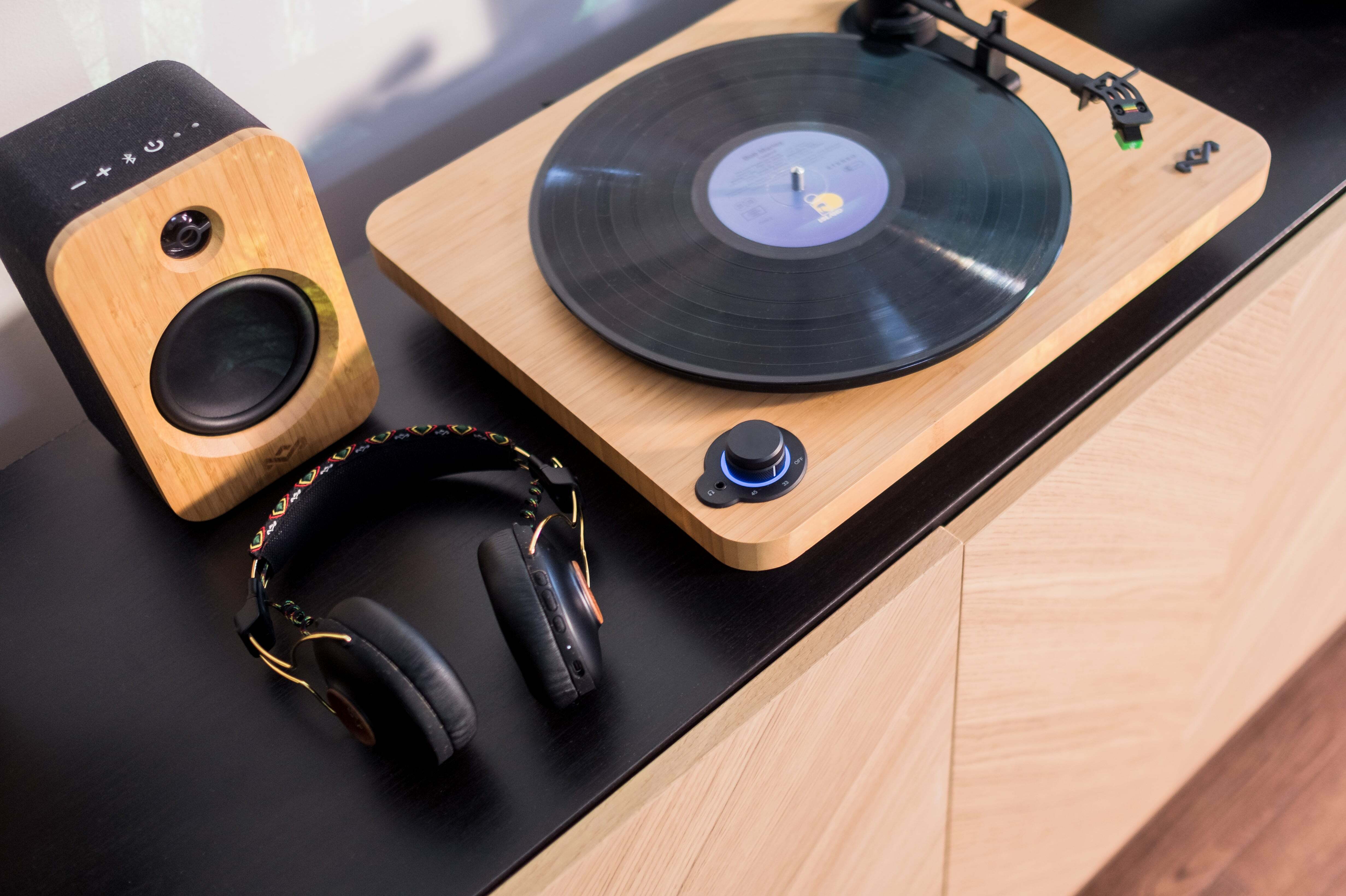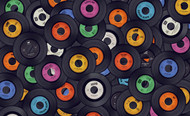How Do Vinyl Records Work?
Posted by House of Marley on Apr 1st 2024
In the long, storied history of music, few mediums have stood the test of time quite like vinyl records. These classic symbols of auditory art have woven their way through decades of technological advancements, retaining a charm that transcends generations. As we witness a remarkable resurgence of vinyl in a world dominated by digital formats, it's fascinating to delve into how these grooved discs capture and reproduce sound. This blog takes you on a journey through the history, science, and artistry of vinyl records, unraveling the magic behind their enduring appeal. From the early days of Edison's phonograph to the modern turntables of House of Marley, let's explore the captivating world of vinyl records and discover why they continue to spin the hearts of music lovers worldwide.
The Evolution of Vinyl Records
The evolution of vinyl records can be traced from Thomas Edison's phonograph in 1877 to Emile Berliner's gramophone, which paved the way for modern vinyl records. The journey of vinyl records can be divided into several key stages:
- Thomas Edison's Phonograph (1877): Edison's invention used a tin foil-covered cylinder to record sound vibrations.1
- Emile Berliner's Gramophone: Berliner's flat disc design replaced the cylinder, making it more practical for mass production and use.1
- First Commercial Vinyl Long-Playing Record (1930): RCA Victor launched the first commercial vinyl long-playing record, which played at 33 1/3 rpm and was pressed onto 12" diameter flexible discs.2
- Decline of Shellac Records (1950s-1960s): Shellac 78 rpm records stopped being produced in favor of vinyl records due to their superior sound quality and durability.1
- Compact Disc (CD) Era (1982): CDs became available to the public, offering a digital alternative to vinyl records.1
- Vinyl Record Revival (2008-Present): Vinyl records experienced a resurgence in popularity, with sales increasing significantly and even surpassing CD sales for the first time since 1986. This revival is attributed to the unique, warm sound quality that vinyl offers, which appeals to music lovers in the digital age.2
The evolution of vinyl records reflects the changing dynamics of the music industry, from the early days of limited recording capabilities to the modern era of high-fidelity sound. It's a story of innovation, adaptation, and the enduring love for a more authentic musical experience. The resurgence of different types of vinyl records in the digital age demonstrates that despite the convenience of digital music, there is still a strong desire for the tactile and audiophile qualities that vinyl records offer.
The Science Behind Vinyl Sound
But how do vinyl records work? Vinyl records work by transforming sound waves into physical grooves on a vinyl disc. These grooves, with their hills and valleys, mirror the original sound wave's vibrations. When a record spins on a turntable, the stylus, or needle, travels through these grooves. The movement of the stylus mimics the original sound vibrations, which are then amplified and transformed back into sound waves that we can hear. The precision with which these grooves are crafted determines the clarity and depth of the sound, making each record a work of art. The stylus's ability to navigate these grooves accurately is crucial, as even the slightest deviation can alter the sound, demonstrating the delicate balance between the physical medium and the audio output.3
Vinyl records have a unique, warm sound quality that appeals to music lovers in the digital age. Vinyl records capture the nuances and subtleties of the original recording, making them a popular choice for audiophiles. Vinyl records have a distinctive sound, filled with surface crackles, pops, and distortion that people love. Vinyl records are an end-to-end analog format, from the recording and pressing to playback, that more closely reproduces what the artist originally intended.4
The Art of Vinyl Record Production
The production of a vinyl record is an art form in itself. It begins with an analog master recording, often a lacquer disc, which is carefully crafted by a mastering engineer. This master disc is used to create stampers, which press the grooves into the vinyl discs.
Unlike digital recordings, vinyl captures the analog sound's unique qualities, preserving the warmth and depth often lost in digital formats. This analog nature is what many vinyl enthusiasts cherish, as it offers a more authentic listening experience.
How are vinyl records made? The process of pressing a record is both delicate and precise, requiring skilled craftsmanship to ensure the highest quality. From the initial recording to the final pressing, each step is crucial in creating a vinyl record that truly resonates with its listeners. The artistry involved in this process is not just technical; it also requires a deep understanding of how sound behaves and how it can be best represented in the physical form of a record.
This blend of technical skill and artistic insight is what makes vinyl records so special and sought after by audiophiles and music lovers alike.
Vinyl Playback: From Grooves to Music
So, how does a record player translate these grooves into the music we love? The process is a blend of mechanical and electrical engineering. As the record spins, the stylus navigates the groove's contours, vibrating in response. These vibrations are converted into electrical signals by the cartridge, then amplified and sent to the speakers.
The parts of a record player, from the platter that spins the record to the tone arm that holds the needle, all work harmoniously to bring the vinyl to life. The quality of these components can greatly affect the sound output, so choosing a record player is a crucial decision for any vinyl enthusiast.
The intricate interplay of these components brings the music to life and adds to the overall experience of listening to vinyl. Each component of the record player, from the stylus to the motor, plays a specific role in ensuring that the vinyl's grooves are translated accurately into sound, capturing the essence of the original recording. This complex yet harmonious process is what makes vinyl playback uniquely rich and immersive.
The Vinyl Experience
Playing vinyl records is more than just listening to music; it's an experience. From the ritual of sliding the record out of its inner sleeve to the anticipation as the needle drops, every step is part of the allure.
Vinyl records offer a tactile and auditory experience that digital music can't replicate. They're not just for music connoisseurs and collectors; they're for anyone who appreciates the art of music in its most physical form. The act of flipping through a collection, selecting a record, and placing it on the turntable creates a connection with the music that is deeply personal and immersive.
This ritualistic aspect of vinyl playback is one of the many reasons why vinyl continues to captivate the hearts of music lovers around the world. The crackle and pop, the rich sound, and the physical interaction with the medium make vinyl listening a deeply engaging activity. It's a journey through sound that allows listeners to slow down and truly appreciate the artistry and craftsmanship that goes into each record.

Give Your Vinyl Records the Best with House of Marley
To truly appreciate the vinyl experience, you need the right equipment. House of Marley's headphones, turntables, and speakers are designed to complement the rich sound of vinyl. Our high-performance audio products are crafted with unique materials, aligning with a commitment to quality and sustainability.
When you pair your vinyl collection with House of Marley's audio products, you're not just listening to music; you're experiencing it in the way the artist intended. House of Marley's products are not only about superior sound quality; but also the embodiment of a philosophy of environmental responsibility and ethical manufacturing, making them a perfect match for the vinyl enthusiast who values both music and the planet.
Vinyl records are a testament to the enduring power of music. They remind us that in our fast-paced, digital world, there's still a place for the tangible, the analog, and the real. Whether you're a seasoned record collector or new to the world of vinyl, understanding how these records work enhances your appreciation for them. So, next time you put on a vinyl record, take a moment to appreciate the science, the art, and the history behind it. Happy listening!
Sources:
- Katz, Russ. 2020. “A Brief History of Vinyl Records – the Vinyl Revivers.” The Vinyl Revivers. 2020. https://thevinylrevivers.com/a-brief-history-of-vinyl-records/.
- Holdener, Michele. 2022. “The History of Vinyl Records: An In-Depth Guide.” The Sound of Vinyl. January 5, 2022. https://thesoundofvinyl.us/blogs/vinyl-101/the-history-of-vinyl-records.
- Burns, Verity. 2020. “Does Vinyl Really Sound Better?” Www.sciencefocus.com. October 16, 2020. https://www.sciencefocus.com/science/does-vinyl-really-sound-better.
- Christopher, Brianne. 2021. “The History and Science behind Vinyl Records.” COMSOL. August 17, 2021. https://www.comsol.com/blogs/the-history-and-science-behind-vinyl-records/.













